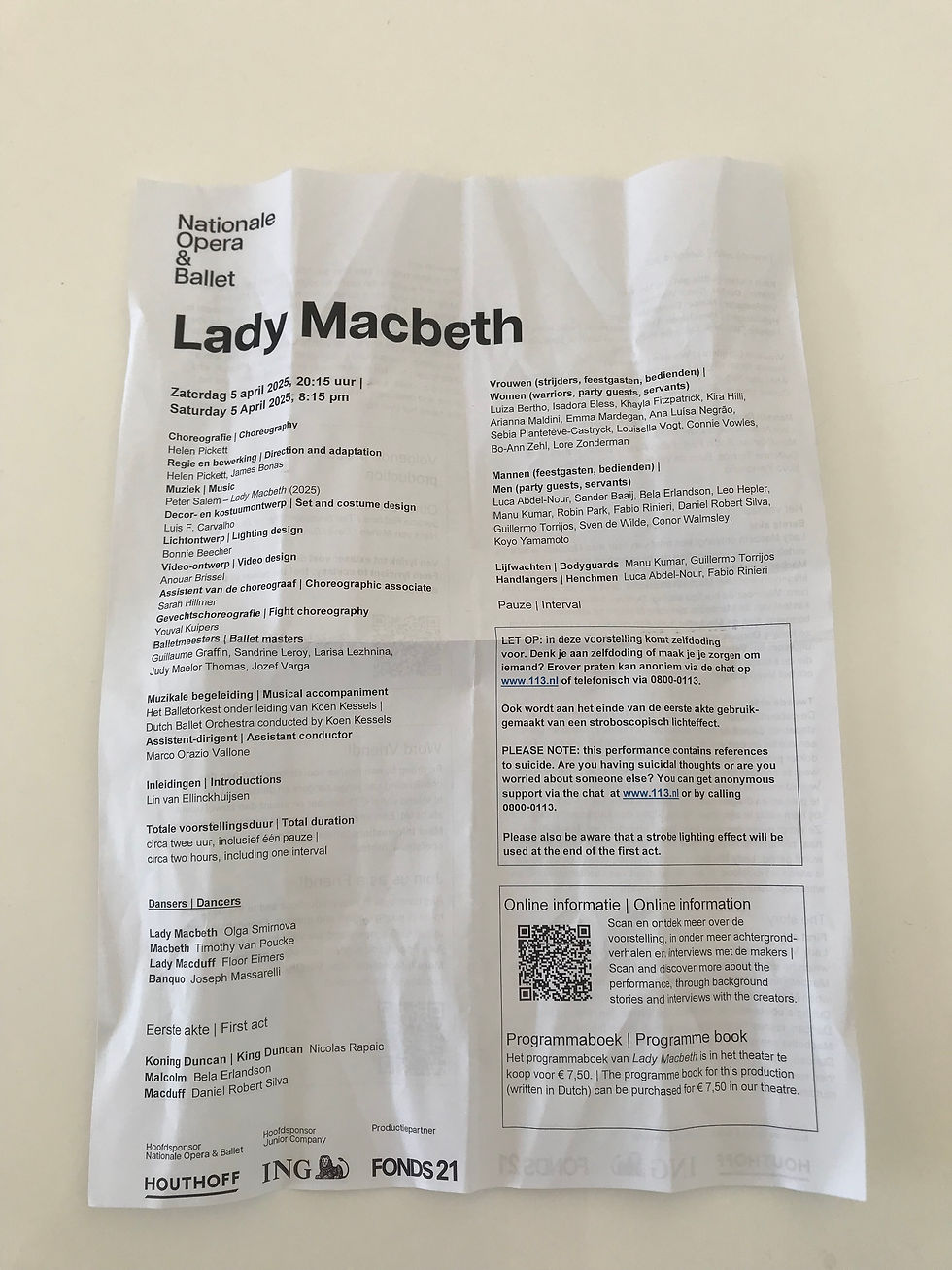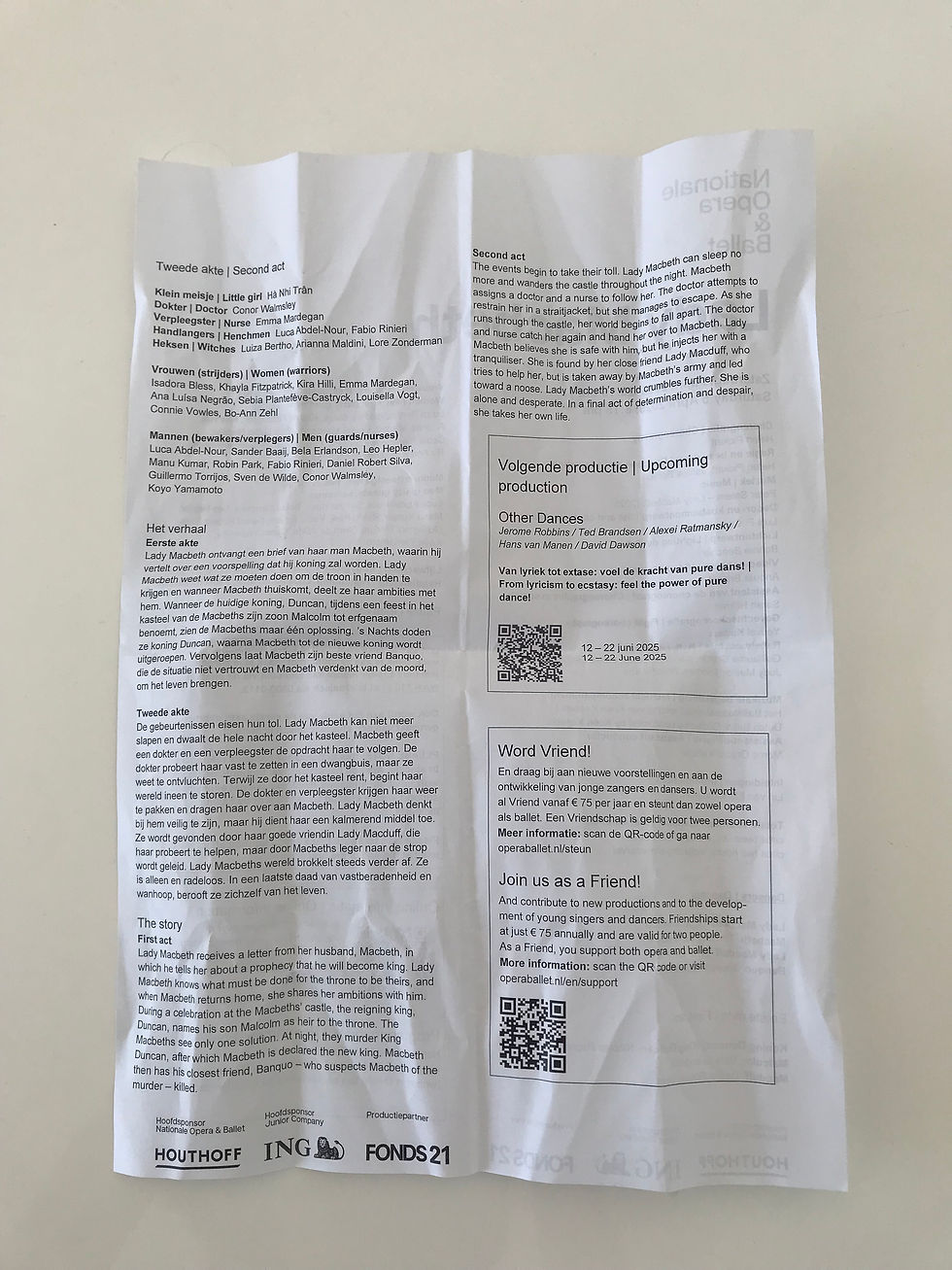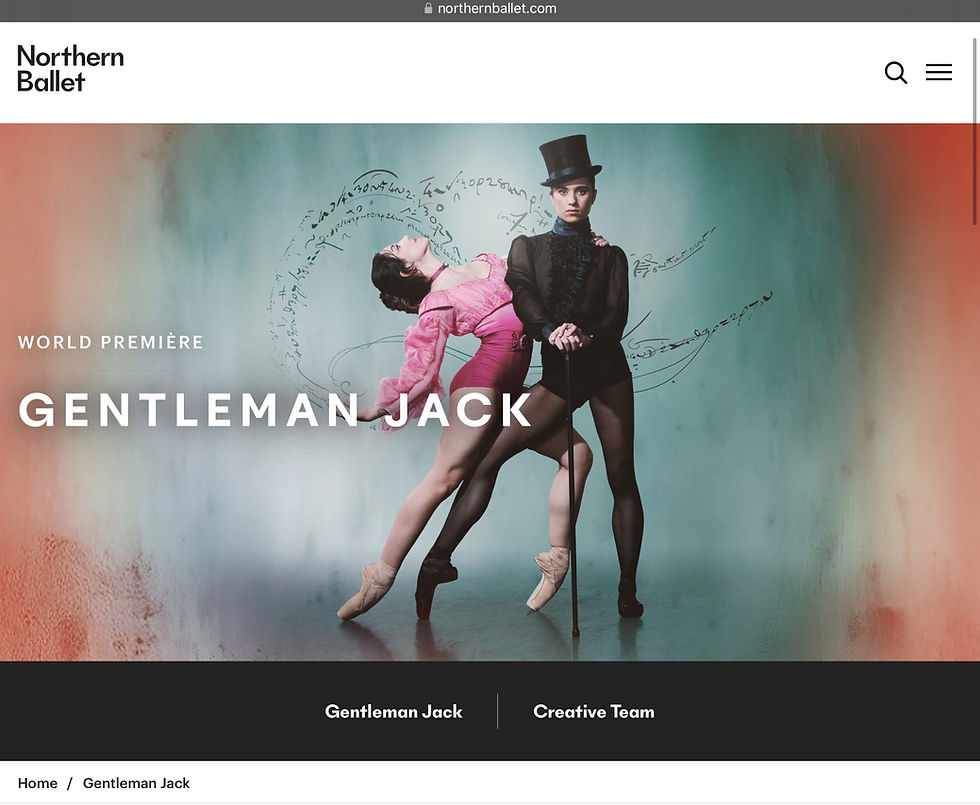Review: Dutch National Ballet's Lady Macbeth - Do not expect Shakespeare
- Ikuko
- Apr 28
- 6 min read
Updated: Apr 29
I went to Amsterdam to watch the world-premiere of Lady Macbeth by the Dutch National Ballet on 5th April 2025. It was gifted by my relatives belatedly for my birthday, which is January. It was definitely the best birthday present ever.
Lady Macbeth was choreographed and “treated” by Helen Pickett based on William Shakespeare's well-known play Macbeth and co-directed by James Bonas, set to the newly commissioned score by Peter Salem (Lady Macbeth, 2025). The set and costume were designed by Luis F. Carvalho. For full credit, click here.
The Dutch National Ballet’s artistic director Ted Brandsen was so impressed by The Crucible, Pickett’s work for the Scottish Ballet, which I have never had an opportunity to watch, he commissioned her to create a new full-length ballet for his company.
Lady Macbeth was also notable as the first full-length ballet created for Olga Smirnova since she left Russia and joined the Dutch National Ballet in 2022 following the breakout of the war in Ukraine. Equally wonderful Anna Tsygankova and Anna Ol were casted for the title role alternatively. All three are Russian ballerinas.
Apparently, the ballet was intended to show events that were not shown in the play (click here for Pickett and Bonas’ interview). How exciting! In the Shakespeare Macbeth, some important events take place off stage, some of which are the murder of King Duncan and Lady Macbeth’s death in a presumed suicide.
I confess I had known the plot only roughly and never watched Macbeth before. so I educated myself with the video-recorded version of Macbeth in 1979, with splendid castings of Ian McKellen as Macbeth and Judi Dench as Lady Macbeth.
I had expected the Lady Macbeth ballet to be an offshoot of Macbeth like Rogue One and Solo to the main Star Wars films. And with creativity like Dr. Liet Kynes and Duncan Idaho in Dune. In the book, Dr. Liet Kynes is a man and he is left to die in the vast desert. The planetologist is a woman in the film (Sharon Duncan-Brewster) and she goads a gigantic sandworm into swallowing both her and her attackers to death. On the other hand, Duncan Idaho in the film (Jason Momoa) died exactly how I visualised in my head when I read the book.
And I love Scotland.
The most importantly, what kind of personality Lady Macbeth would be? Would she be ambitious yet in love with her husband like Judi Dench? Or seductive and calculative like the Thandiwe Newton character in film Chronicle of Riddick?
So here I was, sitting in the opera house in Amsterdam feeling like a happy little girl with high expectations. I was thinking, “this is going to be dark.” The curtain went up and the amazing Smirnova stood strong, wearing an enormous drapes in dark blood colour. She took off the drapes and revealed a slim fit (Star Trek-like) unitard… and walked on a table.. and danced with a group of dancers in dark-coloured (Star Trek-like) unitards.
Quite surprisingly, the opening did not really set the undertone of the ballet. After a quick costume change mayhem, Smirnova wore a rather elegant red dress. Dancers stepped on stage dressed in colourful Greek-ish costumes. The background was the Romanov-inspired shape-shifting stage set like the Gryffindor staircase, which took up lots of dancing space - it seemed a door on stage right did not work (click here for Carvalho's interview).

It was none of Shakespeare. Choreography, stage and costume designs, and music (which was supreme as a stand-alone score) lacked relevance or chemistry. Modern interpretation of Shakespeare is not unusual. But there was no main theme in this Lady Macbeth ballet. There was no coherence. It looked like a collage work of Romeo and Juliet, Manon, Mayerling, Spartacus, Woolf Works, Maurice Béjart, Roland Petit, Alexander Ekman, Marcos Morau, Akram Khan’s Creature (underappreciated), Frankenstein (I have never watched the ballet in theatre), Crystal Pite and Christopher Wheeldon.
Because this was ballet, the most troubling element was the underutilisation of these world-class dancers despite the bits and pieces of physically demanding choreography. There was an exuberant moment in the first act when the music turned Scottish in the first act. But that did not last long.
I couldn’t miss more troubling elements. Some of the events, which usually happen offstage in the Macbeth play, were certainly shown in the ballet as Pickett had promised. They were done so by bending the story wildly and not in a sophisticated way although some may call it creative freedom.
In the play, audience learn that the murder of King Duncan has taken place off stage as Macbeth reappears to the stage carrying a bloody dagger. And he acts alone. Lady Macbeth convinces him to do so but is not his companion. In the ballet, he and Lady Macbeth killed the king together. At this point, my better half heard the Spanish audience sitting next to him scream “Qué?!” After another quick costume change, Lady Macbeth wore a white skinny sleeping dress but no blood anywhere. (There were more alterations in the plot and some unmissable logic flaws but I would not write hundreds of lines to point them out.)

Furthermore, the interpretation of three main characters, Lady Macbeth, Macbeth (Timothy van Poucke waste of talent) and Lady Macduff (Floor Eimers waste of talent), in the second act troubled me. Lady Macbeth turned into a mental patient and ran around the stage, wearing the white sleeping dress. In contrast, her well-groomed husband calmly assumed the office and handled day-to-day business even though he earlier freaked out seeing the ghost of Banquo (among modern looking a dozen or so cooks in a stylish modern kitchen), which was visible only to him. Somehow three witches, who give Macbeth prophecy and kick off the whole tragedy rolling in the play, finally arrived beautifully on stage and started haunting Lady Macbeth.

Macbeth did not even care about his wife's mental health now that his coup seemed to be successful. He ordered modern-looking doctors to put her in a restraint jacket but she ran around like a headless chicken anyway. So he injected her tranquilizer (in the Shakespeare era). So she, the prima ballerina, passed out on stage rather than dancing.
Lady Macduff was depicted as the best friend of Lady Macbeth in the ballet and was present on stage throughout. In the play, she is murdered by Macbeth's assassins early on while her husband is away visiting King Duncan's son in England to discuss a plan to uprise against Macbeth. Her murder is one of the building blocks to set up the climax of Macbeth's fall.
In ballet, Macbeth executed Lady Macduff. He ordered her to walk to a noose and hang herself as his law-enforcement minions, who were dressed in rather stylish uniforms with M logos on, coldly looked on. Really? I am still puzzled why the hanging was necessary (Let me know if you have any clues). Only then, Lady Macbeth woke up to see her friend's green mile and cut her wrist. The end. Click here for the synopsis.
If Macbeth is that cold, what is the point of the "Tomorrow, and tomorrow, and tomorrow" soliloquy?
Was it a political message? If so, I was not intelligent enough to get it (please let me know if you have an idea). Rather, as a woman, I could not help feeling demeaned. By putting women in the centre stage, the Lady Macbeth ballet seemed to demean women and I took it personal. I sensed a slight hesitation among audience before they started applauding.
Creating a story telling ballet is tricky. Logic flaws are common in ballet because of the nature of the art form and they can be often ignored. But the Lady Macbeth ballet's poor synopsis and poor stage production produced a little too much negative synergy.
In comparison, Tamara Rojo's Raymonda had many flaws in the plot and the consumes were not necessarily optimal for the ballet. Nevertheless, its main priority was dance. The dance was superb and enjoyable that these weak points were somehow laughed at and forgiven.
After the curtain down, my mother-in-law, an avid opera lover, said she loved the Lady Macbeth ballet, then asked me, "Which one was Lady Macbeth?"
A few days later, I happened to see my acquaintance, who is a well-respected and well-connected figure in the Dutch ballet and dance industry. He said he had to dash out at the curtain down to avoid being asked for his view about Lady Macbeth.
"It's shame because it was so expensive to create it. Now they have to look into it," he said to me.
A further few days later, I found this review about Pickett's Crime and Punishment in The New York Times.


